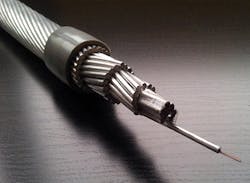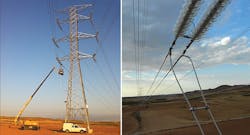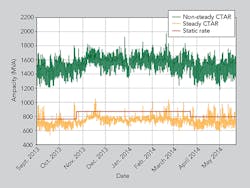More Capacity Allows More Renewables
Traditionally, the thermal transmission capacity of an overhead line was determined based on static seasonal parameters. It did not take into account actual meteorological conditions — namely, wind speed and direction, solar radiation and ambient temperature — which, in fact, determine the real load-transfer capacity.
The need for integrating new intermittent sources of energy into the transmission system requires a more accurate and real-time assessment of the transmission capacity of overhead lines in a continuously changing environment. The objective is to demonstrate that surplus capacity exists in transmission lines directly involved with the connection of wind energy resources. This would enable dispatch control centers to use the extra capacity to bring flexibility to and expand the capability of the network by integrating more energy resources while maintaining the necessary level of system reliability.
A Demonstration Project
A large-scale demonstration project was launched in Spain to explore the idea that real-time thermal rating (RTTR) devices and algorithms can help to increase transmission flexibility to support massive renewable integration. Led and developed by the Spanish transmission system operator Red Eléctrica de España S.A.U. (REE), this demonstration project took place as part of the European TWENTIES project’s research and development framework.
An innovative application and test bed of an optical phase conductor (OPPC) on an overhead transmission line combined with a set of weather stations and software were established. The objective was to increase the capacity of the existing system by assessing the real-time thermal behavior of the overhead line circuit.
Technical Characteristics
The study was conducted on a new 220-kV overhead transmission line erected between the Maria and Fuendetodos substations, located in the region of Aragón in northeastern Spain. Commissioned in November 2012, the circuit is located in an area where 1,730-MW wind power capacity is installed.
One subconductor of the twin bundle in the lower phase was replaced by an OPPC to measure the temperature of the conductor along the line using a distributed temperature-sensing (DTS) system. The lower phase was chosen not only to facilitate the assembly and laying processes, but also because this phase is the most critical according to the mandatory safety clearances and could be less influenced by the favorable conditions experienced on windy days.
Designed according to European standards, the OPPC includes 10 single-mode optical fibers inside a stainless-steel, aluminum-coated tube located in the inner aluminum layer, close to the steel core of the conductor.
Monitoring System
Using a DTS system, a laser pulse is sent through the OPPC fiber optics, and by processing this signal — using optical time-domain reflectometry based on the Ramman effect — it was possible to monitor the temperature with ±2C° (±3.6F°) accuracy level. The temperature was not measured at a single spot but at 2-m (6.6-ft) intervals over the length of the conductor every 10 minutes. As a result, the temperature profile could be obtained detecting hot spots along the entire route at any time.
To collect the actual meteorological conditions, six weather stations were installed on six tension towers along the line, properly oriented and located 10 m (32.8 ft) above ground level in accordance with the minimum ground clearance. Each weather station consists of two solar panels, batteries, multi-sensors (including an anemometer, an ambient temperature, a rain gauge, a barometric pressure sensor and a radiation sensor) and a charge controller, which first supplies the communications system and then supplies the batteries.
It is common knowledge the temperature of overhead line conductors is mainly dependent on the wind speed and direction, so transmission lines directly involved in the evacuation of wind energy can take advantage of their location and have an increased load-transfer capacity when the wind is highest, and, consequently, the wind generation is more significant.
Therefore, selecting the right locations for the weather stations proved to be one of the major challenges of the project. It was necessary to get a detailed weather profile of the selected area. Based on the profile, the predominant wind direction was mostly perpendicular to the route of the transmission line between tower No. 47 and the Maria substation, and mainly parallel to the transmission line between tower No. 47 and the Fuendetodos substation.
The Central System
Conductor temperature, current values, time signal, weather conditions and other calculations were sent to a new central system developed for data acquisition, located at REE headquarters, through an Internet-protocol network that allows collection and registration of the data instantaneously with all synchronized devices.
The central system is responsible for storing transmission line temperatures and weather station data, and calculating and forecasting the precise thermal transmission capacity every 5 minutes in the following formats:
- CTAR (RTTR): The dynamic rating of the transmission line, updated every 5 minutes, in megavolt-amps
- CTAO (RTTR for operating purposes): The dynamic rating value in megavolt-amps, which remains stable and valid for a 30-minute period; gives system control operators a constant figure rather than a moving value and based on PCTAO calculations for the next 30 minutes
- PCTAO (forecasted RTTR for operating purposes): The forecasted value in megavolt-amps for the next 30 minutes, one hour, two hours and four hours ahead in real time (that is, short term); uses historical data (the central system needs at least 10 days of historical data) to predict the ampacity of the transmission line for a given weather forecast window.
For real-time operation, it is necessary to show — through supervisory control and data acquisition (SCADA) — five significant variables calculated by the central system:
- CTAO, for the last execution
- Maximum mean temperature of the critical span
- PCTAO for one hour, two hours and four hours ahead in real time
- Seasonal ratio in megavolt-amps
- Actual power transmitted in megavolt-amps.
If the seasonal ratio indicated that the transmission line would be overloaded, the system control operator could see whether the line was at risk by checking the conductor temperature in the critical span, enabling determination of the operational margin. If the operator decided to operate the line according to the RTTR, it would be necessary to know the PCTAO values for one hour, two hours and four hours ahead in real time.
Preliminary Results
Data and measurements taken over three months were used to perform a preliminary analysis. With the aim of showing the temperature profile and its daily variation, one day was selected, as an example, to study the temperature evolution. Three time checks were chosen: 03:00, 11:00 and 19:00 hours. In the analysis, the conductor temperature profile was spliced into several sections. Section 1-2 is the closest one to Fuendetodos substation and section 85-86 is the closest one to Maria substation.
Temperature steps between sections were observed. This demonstrated the wind-direction effect on the load-transfer capability of the transmission line; wind-direction changes were checked in several sections along the route to determine the variability of the conductor temperature.
When the conductor was around 15°C to 20°C (59°F to 68°F) with low load, there were mean temperature differences up to 5C° (9F°). However, temperature differences up to 12C° (21.6F°) were found in isolated points with 50 m (164 ft) of distance between them.
According to the results, when the load increased and the transmission line conductor temperature was grossly different from the ambient temperature, higher punctual differences were found. Therefore, measurement of conductor temperature at a single point on the overhead line is considered to be insufficient for RTTR modeling to determine real-time load-transfer capability.
This is one of the reasons why a DTS system was installed on the transmission line to monitor the temperature continuously instead of in discrete points on the line.
Wind Power Integration
As a result of using dynamic ratios, it is possible to integrate approximately 213,000 MVAh of additional renewable energy. This represents an increase of 15% from the energy transmitted in the static situation.
The calculations completed to date show the maximum CTAR achieved is 168% higher than the seasonal ratio, and the minimum CTAR is 27% lower than the seasonal rate — climatic conditions under rare situations, namely, zero wind speed coinciding with high ambient temperatures and solar radiation.
With the information given by the RTTR system, it is possible to integrate more wind power in the electrical system, taking advantage of the fact the load-transfer capacity of the Maria–Fuendetodos transmission line increases when the local wind power increases. Thus, when the wind energy production is highest, the CTAO also is high because of the cooling effect of the wind.
A group of 10 wind farms with a total installed capacity of 392.5 MW is located near the Maria–Fuendetodos transmission line. These wind farms have been used to analyze the correlation between the wind power production and the ampacity of the line.
Additional Capacity Revealed
The technology under review passed all the technical validation phases by simulations, laboratory testing and, finally, field tests, demonstrating the functionality was achieved successfully. The main results obtained from this project were as follows:
- It has been identified, for most days, the dynamic line ratio is an average of 15% higher than the seasonal rating. On days with more wind generation, the dynamic rating can be higher than 100% of the static one.
- The demonstration recorded 15,020 points of temperature readings every 10 minutes. This meant it was possible to operate the line using dynamic thermal ratings instead of the seasonal ones.
- Hot spot could be detected for maintenance purposes.
- RTTR also permitted study of the correlation between wind production and the increase of transmission capacity in lines affected by the same local weather conditions.
The use of OPPCs to assess the operating temperature can be a powerful tool to validate the thermal models of overhead lines. It has to be combined with the use of weather stations along the route to validate a proper approach for dynamic ratings and wind assessment.
Therefore, a sensible application of this technology can provide extra capacity for the renewable generation integration as well as allowing more efficient management of the transmission system without impairing security of supply.
Antonio Useros García ([email protected]) has a BSEE degree and a master’s degree in electrical power industry, and is a member of the power lines engineering department at Red Eléctrica de España. His primary interests include the development of new overhead and underground transmission lines, as well as the uprating of existing circuits. Useros also is responsible for managing research and development projects related to the efficiency and reliability of the transmission network. He is a member of national and international working groups with various scopes linked to transmission systems.
Sara Fernández de Sevilla Alfonsea ([email protected]) has a BSEE degree and is a member of the power lines engineering department at Red Eléctrica de España. Fernández is involved in the development of new transmission lines and the uprating of existing circuits, as well as in the assessment of new extra-high-voltage interconnection lines between Spain and France. Fernández also is responsible for managing Demo 6.1 part of the European TWENTIES project and R&D projects related to the efficiency and reliability of the transmission network, collaborating with several CIGRE and EPRI international working groups.





